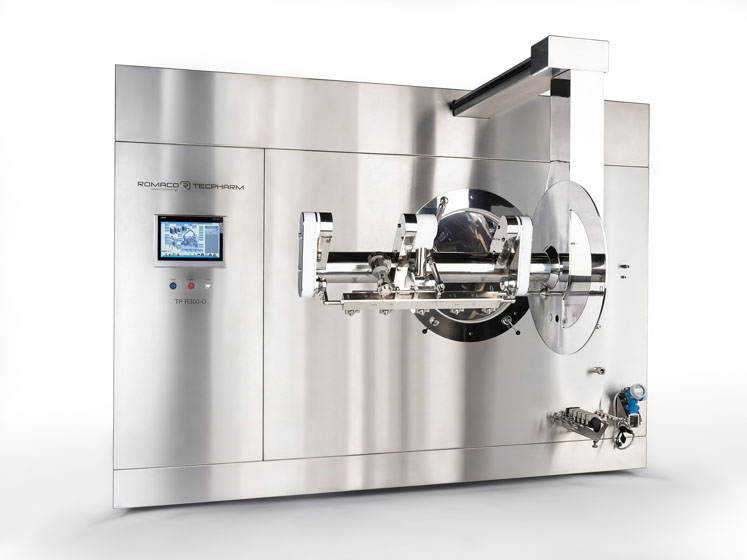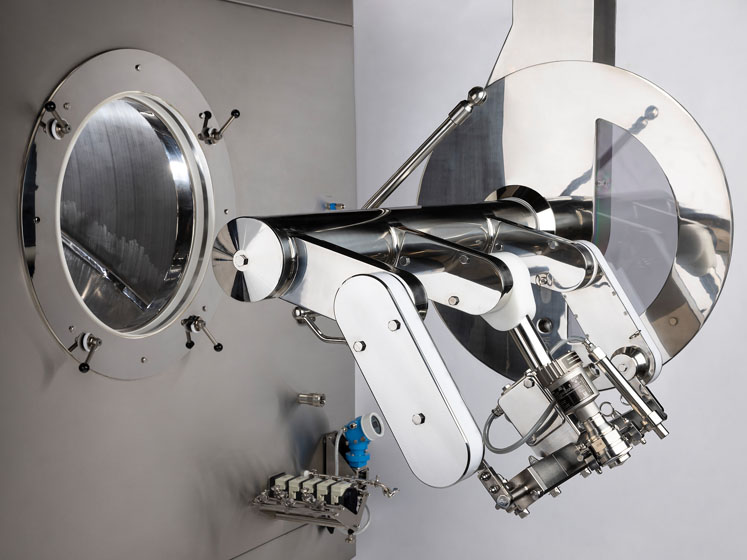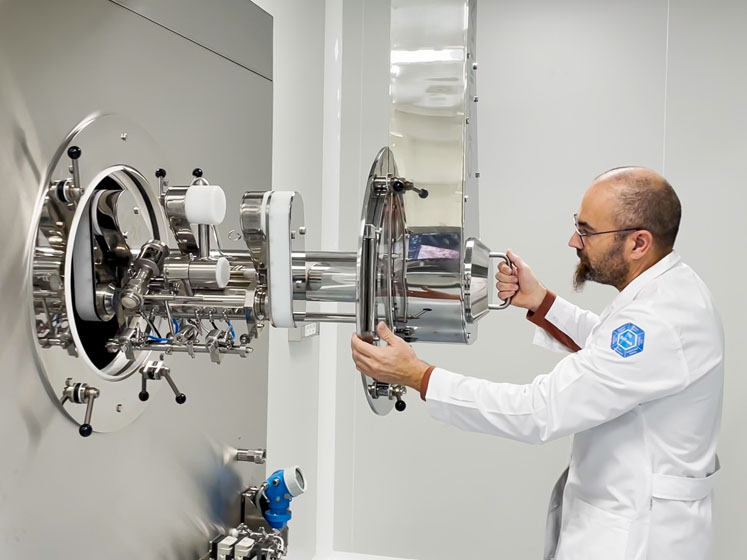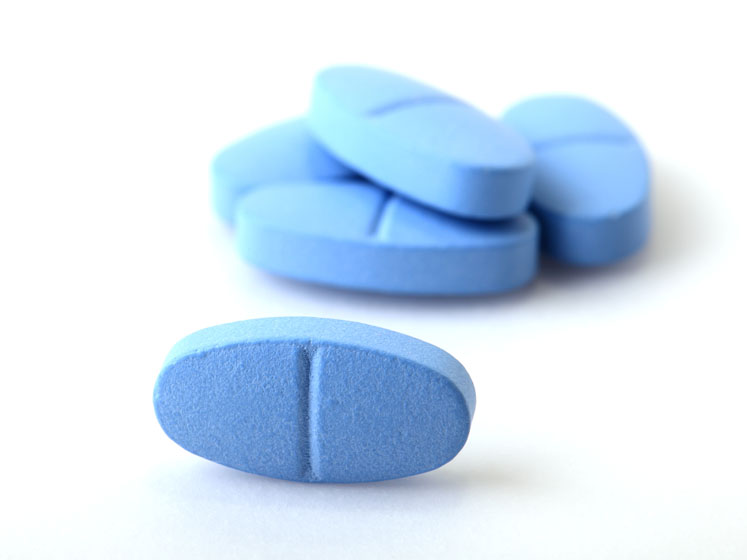Coating is an integral part of pharmaceutical tablet and pellet production. Nevertheless, there are some problem areas that have not been adequately solved so far. Although some of these issues are tolerated, they have an impact on almost every coating process and entail economic losses.
To a certain extent, this is because of a presumed lack of possible solutions. Promising remedies do, however, exist, such as a new generation of tablet coaters that addresses these challenges in an innovative way. There are basically three hurdles to overcome: the quality of the coating (product), the productivity of the coating process and the flexibility of the tablet coater (process).
How can high-quality coating be ensured on a continuous basis?
One of the first things that comes to mind when thinking about product quality is the prevention of defects: from aesthetic ones such as discoloration, tablet-to-tablet colour variability or logo bridging to functional ones such as film cracking, tablet breakage and tablet edge or surface erosion.
Although purely aesthetic defects are sometimes tolerated, the entire batch is at risk (and, in many cases, rejected) once the functionality of the product is compromised.
Depending on the product, this can mean losses in the six-figure range. It is therefore not surprising that this area is the one that all companies producing for the pharmaceutical industry are grappling with … and have implemented their own procedures to do so.
As differentiated as these approaches may be in detail, it is always a matter of stabilising the coating process by regularly checking parameters and adjusting them if necessary.
The common way to enhance and simplify this process control is to improve the technical feedback: that is, how well and quickly the technical systems relay process and product quality feedback to the operator.
After that, it is the operator’s responsibility to react accordingly. This is definitely a solution that works … but is it enough to achieve real process stability?

The reality is that this approach involves a relatively large risk of errors and inaccuracies; the regulation and optimisation of the coating process is absolutely dependent on the expertise, experience and capability of the operator.
What if there is no suitably skilled operator available because of the shortage of skilled workers in the labour market? What if the expert retires or is simply on vacation and there is no appropriate replacement? And, if a suitable operator is available, what happens during long coating processes that require 20 or more hours and therefore include shift rotations?
All these and similar scenarios aside, it’s not always easy — even for the most experienced operator — to define the ideal coating settings and keep track of all the parameters. This is especially true when dealing with batch size changes, complex coating processes or demanding products that are, for example, very sensitive to humidity or temperature.
The solution to this systemic uncertainty is to automate the coating process, including control of the relevant parameters and feedback to the operator, as well as fully automatic adjustment when required. The new TP R Optima perforated coating pan from Romaco Tecpharm is capable of doing so.
It monitors parameters such as temperature, humidity, flow rate, batch quantity and much more, obtains the predefined optimal coating conditions for the specific product and thus minimises the risk of losing parts of or entire batches.
It could be said that the TP R Optima tablet coater ensures an absolutely reproducible coating process — irrespective of complexity. Of course, operator expertise is still needed and they can manually intervene if they choose to.
But, the potential for almost complete automation ensures that you no longer have to be an expert to achieve consistently high product quality with this technology. It is somewhat like having an autopilot. But what does this automatic self-regulation look like? This is illustrated in the context of the second main problem area, wherein automation is also the method of choice for optimisation.
How can coating be more cost-efficient and sustainable?
Deficiencies in the productivity of coating processes were — and are — generally accepted as a given. An example is the amount of “wasted” suspension that is factored in; it’s common to plan for 50% more suspension than is theoretically needed to coat a product — because a loss of up to 40% is considered normal.

With “standard” coatings, this may not incur any major financial losses; but, with functional coatings, such as those containing an active pharmaceutical ingredient (API) or that offer controlled release, the situation is quite different.
Yet, even with standard coatings, there are hidden costs in the form of cleaning and disposal expenses, not to mention logistical expenses; if more suspension is needed, more must be transported and stored.
On top of all that, this form of “resource wastage” and “environmental impact” is no longer an option, given the global change in awareness of sustainability and the corresponding legal regulations. Manufacturing companies must react now or they will fall behind.
Here, automation also plays a role, particularly regarding the automatic adjustment of suspension application and drying. Technically, this is implemented in the TP R Optima as follows: using sonar technology, acoustic wave sensors continuously measure the volume and inclination of the product bed, which varies according to the turning speed of the drum.
If modifications are required in terms of the ideal spray distance or the appropriate spray angle, the intelligent system effects this by means of a nozzle arm with a three-point extension mechanism during the ongoing process (the machine does not have to be paused for this purpose).
Drying is regulated automatically via a vacuum generated inside the drum, which varies depending on the batch size and via automatic air exhaust flaps, which can be opened individually and continuously.
This permits precise regulation of the path taken by the air flow through the tablet bed, ensuring that the coating does not simply run over the product before being discharged again (unused).
A no-loss suspension application is not yet possible; but, with the new technical possibilities of the coating technology from Romaco Tecpharm, only 10–15% more coating medium is needed instead of 40%.
But the “sustainability factor” of the automation goes beyond reducing both spray loss and water consumption during cleaning. More efficient drying and the ability to make adjustments without interrupting the coating process reduce process times by hours.
And, prior to the actual coating, time is also saved when fine-tuning and preparing a new batch; the TP R Optima virtually adjusts itself to the recipe and the associated parameters. It also offers the option of taking product samples while the process is running.
In doing so, regulatory requirements can be met without sacrificing time. All of which contributes to substantially lower energy use. Another benefit is the significant batch size variability that can be accommodated with a single machine, which increases both productivity … and flexibility.
Preparing for new trends, altering market conditions and changing customer requirements
Almost everyone who works in coating has to deal with scale-up and scale-down procedures in some form or another, sooner or later, such as
- when producing for various countries and when batch sizes have to be adapted to meet specific market requirements
- when validation has to be done (requiring approximately 10% of the current batch)
- when producing under contract and a wide range of batch sizes must be processed
- when the switch from laboratory to production-scale is pending
- when market demands simply change with time.
Although it’s very important, the final point is not often considered when investing in coating systems and other machines. After all, lifecycles of more than 20 years are not uncommon for high-quality production equipment and market requirements almost inevitably change during such a long period. Therefore, the ability to scale batch sizes is basically about future-proofing for all coating providers.
But why is scale-up/down a challenge? First, it means that companies need at least two machines (one each to produce smaller and larger batch sizes) as most coaters do not have a large enough batch size variability.
Usually they can only go down to 40% of the maximum batch size at the most. The resulting need for several machines is associated with very high investment costs, energy expenditure and space requirements.

In addition, operational parameters cannot simply be transferred from one machine to another — even if they are the same type and brand. Consequently, a relatively large number of manual adjustments have to be made.
Here, again, the problem of ensuring high quality and uniformity across all products, regardless of the machine or batch size, arises. Not to forget, of course, the time and work that goes hand in hand with manual adjustments.
The automated adaptability of the TP R Optima also represents an approach to improvement here. With the ability to monitor and adjust to varying batch sizes, the tablet coater achieves a batch size range from 10–100% filling volume with one and the same drum.
This eliminates the need for multiple machines because of different volume requirements; it also reduces the time and labour it takes to set up the right parameters for different systems and the risk of errors and imprecisions.
What’s more, this not only applies to validations and batches of different sizes, but also to volume changes within a single coating process (such as coatings with multiple layers). It could be argued that coaters with this range have been around for a while, which is true, but the batch size variability of these solutions necessitated drum changes and manual adjustments.
This genuinely removed the problem of purchasing multiple machines, but not the risks associated with manual intervention. Moreover, the drum changes created extra work and required more cleaning, including for different batches with the same active ingredient. This also becomes largely obsolete with the use of only one drum.
A final aspect of coating flexibility is the ability to change the coating medium itself without major technical alterations. There are several reasons why this could be required. For example, a reformulation may be a necessity owing to imminent and acute bans on formulation components — as in the case of titanium dioxide, which is already banned in food production in the EU.
An adequate substitute is presently being sought for pharmaceutical production as well. Trends towards more natural ingredients such as the departure from alcohol in favour of water-based suspensions may also call for recipe modifications.

Again, automated parameter adjustment provides advantages. In the demanding search for new recipes, experts can concentrate on the formulation and leave the rest to the machine. Apart from that, process times are shorter, which further facilitates R&D activities as more formulation trials can be implemented in a given period of time.
Saving time is also the big issue with water-based suspensions, which have longer drying phases. Owing to more efficient drying with the TP R Optima in “fully” automated mode, this does not have the same impact as with previous technologies. As a matter of fact, the best possible drying is particularly important in this case, as too much humidity is one of the main factors for product defects.
Conclusion and outlook
As illustrated, there is significant optimisation potential in coating that can be exploited through a higher degree of automation. Shorter process times, continuously high product quality, time and cost savings, as well as resource conservation, are just some of the gains.
Tablet coaters such as the TP R Optima with these technological possibilities will certainly represent the future of coating and are already supporting innovation.
Finding novel active ingredients is a very long-term task, which is why many new products will be developed in the next few years through the recombination of known APIs or new forms of drug delivery. Coating will play a central part in this endeavour.
There will be more products with active ingredients in the coating layers and products that have not typically been coated in the past. The preconditions for these new developments are — and will be — automation that stabilises the coating process and makes it both more efficient and sustainable.





